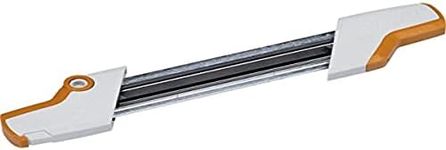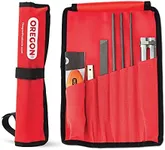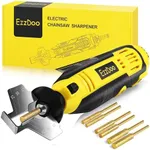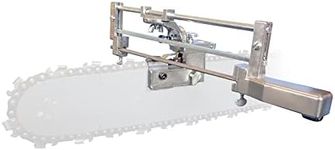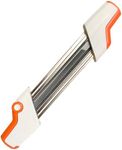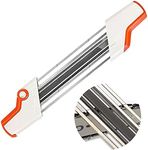Buying Guide for the Best Chainsaw Sharpeners
Choosing the right chainsaw sharpener is important for keeping your chainsaw in top condition and making your work safer and more efficient. A good sharpener helps you maintain the sharpness of your chainsaw chain, which means smoother cuts, less strain on the motor, and a longer lifespan for your equipment. When picking a sharpener, you should consider how often you use your chainsaw, your experience level, and whether you prefer manual or electric tools. Understanding the key features will help you find a sharpener that matches your needs and makes the sharpening process easy and effective.Type (Manual vs. Electric)The type of chainsaw sharpener refers to whether it is operated by hand (manual) or powered by electricity (electric). Manual sharpeners are usually files or guides that require you to sharpen each tooth by hand, which gives you more control and is great for occasional use or for those who like hands-on work. Electric sharpeners, on the other hand, use a motor to spin a grinding wheel, making the process faster and more consistent, which is ideal for frequent users or those with multiple chains to maintain. If you use your chainsaw often or want to save time, an electric sharpener might be best. If you only use your chainsaw occasionally or prefer a simple tool, a manual sharpener could be a better fit.
Compatibility (Chain Size and Pitch)Compatibility means whether the sharpener can work with the size and pitch of your chainsaw chain. Chains come in different sizes and pitches, which refer to the distance between the chain's links and the thickness of the drive links. A sharpener that matches your chain's specifications will ensure a proper fit and effective sharpening. Most sharpeners list the chain sizes and pitches they support, so check your chainsaw's manual or the markings on your chain to find out what you need. Choose a sharpener that covers your chain's size and pitch to avoid frustration and ensure good results.
Ease of UseEase of use describes how simple and straightforward the sharpener is to operate. Some sharpeners have features like angle guides, clamps, or preset adjustments that make it easier to get the right sharpening angle and depth. If you're new to sharpening chainsaws, look for a model with clear instructions and helpful guides. More experienced users might prefer a tool with more manual control. Think about your comfort level and how much guidance you want from the tool when making your choice.
PortabilityPortability refers to how easy it is to move and use the sharpener in different locations. Manual sharpeners are usually small and lightweight, making them easy to carry in the field or store in your toolbox. Electric sharpeners are often larger and may need to be plugged in, so they are better suited for a workshop or garage. If you need to sharpen your chainsaw away from home, a portable manual sharpener is a good choice. If you always sharpen at home, portability may be less important.
Durability and Build QualityDurability and build quality refer to how well the sharpener is made and how long it will last. A sharpener made from strong materials like metal or high-quality plastic will stand up to repeated use and resist wear and tear. If you plan to use your sharpener often or in tough conditions, look for one with a solid, sturdy construction. For occasional use, a lighter-duty model may be sufficient. Consider how much use your sharpener will get and choose a build quality that matches your needs.

